

The architecture of Chung Tai Chan Monastery combines Buddhadharma with art, culture, and technology. Merging tradition with contemporary design, the monastery meets the needs of a modern sangha while remaining deeply connected with Buddhist history. Its main building fuses elements of a traditional monastery and a Buddhist pagoda, providing a refuge for cultivators while silently embodying the Dharma.
Chung Tai Chan Monastery was awarded the Taiwan Architecture Award in 2002 and the International Award for Lighting Design in 2003—a new page in 21st century Buddhist architecture.
Hallmark Features
Chung Tai is located in the Puli Basins, surrounded by Taiwan’s central mountain range. Seen from afar, the monastery resembles a meditator sitting on a lotus pedestal, looking over the world with compassion and serenity.
With expressing the Dharma through form as its guiding design principle, Chung Tai Chan Monastery embodies the teaching and spirit of Buddhism. Its halls and corridors represent the ultimate teaching of the Mahayana tradition, where gradual cultivation and sudden enlightenment are non-dual on the path to buddhahood.
The building’s central axis comprises three main buddha halls, each located on successive floors aligning with the Golden Dome that crowns the monastery. This arrangement symbolizes sudden enlightenment, the most direct path to ultimate truth: “awaken the mind and see one’s true nature; seeing the true nature, one becomes a buddha.” The three halls feature statues of the buddha’s Transformation Body, Bliss Body, and Dharma Body, known as the three-fold body that one manifests upon complete enlightenment.
On either side of the building’s center, pilgrimage stairways leading up to the bodhisattva halls represent the path of gradual cultivation. Out of selfless compassion, bodhisattvas vow to enlighten themselves as well as all sentient beings. They walk the Bodhisattva Way step by step, until perfect buddhahood is attained.
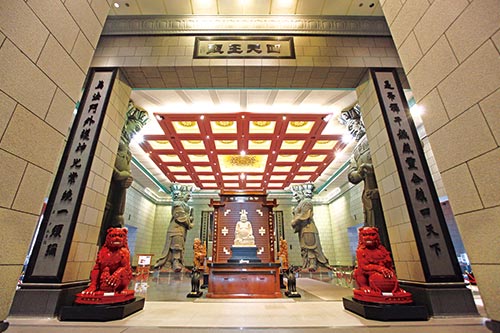
The Hall of the Four Heavenly Kings is the first visitors see in the monastery. The four kings stand 12 meters high in each corner of the hall. Carved from Shanxi black granite, these statues are among the tallest of their kind in the world. Each statue has the faces of all four heavenly kings, symbolizing the teaching that one is four and four is one—they mutually embody each other’s vows to protect the Dharma and look over sentient beings.
Other notable statues include Maitreya, the future buddha, Weituo Bodhisattva, and the 18 arhats.
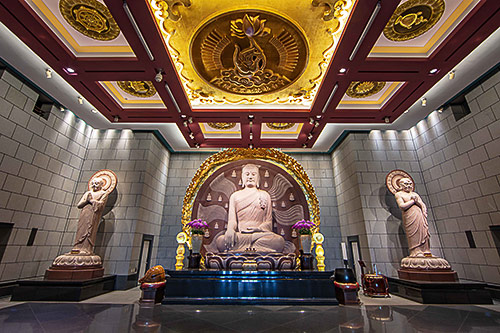
The Great Majesty Hall is located on the monastery’s second floor. It enshrines the statue of Shakyamuni Buddha, the historical buddha as he appeared in the world, also known as the Transformation Body. The statue is carved from Indian red granite, in contrast to the stark grey stone covering the walls. This symbolizes the Transformation Body’s manifestation in the Saha World, a physical embodiment of the Buddha’s compassionate vow to liberate all beings from suffering. With great virtue, wisdom, and power, the Buddha can purify the evil and wrongdoings of this land. Therefore, he is known as the Great Majestic One.
Adjoining the Great Majesty Hall are the Patriarch Halls, enshrining Bodhidharma, the first Chan Patriarch of China, and Sangharama Bodhisattva, Dharma guardian of the monastery.
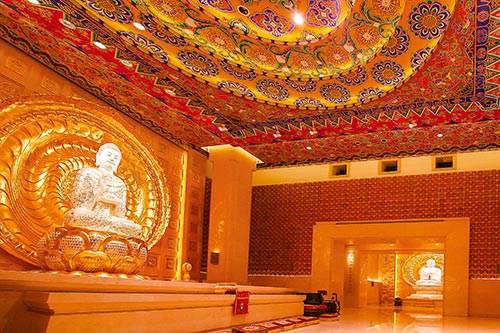
The Great Magnificence Hall on the monastery’s fifth floor enshrines the golden statue of Rochana Buddha, or Bliss Body. Carved out of Brazilian white marble, the statue wears a robe adorned with a thousand golden buddhas and sits atop a golden lotus pedestal. The hall depicts the splendor of the buddha land: surrounding Rochana Buddha are thousands of bronze buddha tiles and a ceiling hand-painted with intricate patterns inspired by the art of Dunhuang in Gansu, China.
The adjoining halls enshrine the Medicine Buddha of the Eastern Pure Land of Lapis Lazuli, and Amitabha Buddha of the Western Pure Land of Ultimate Bliss.
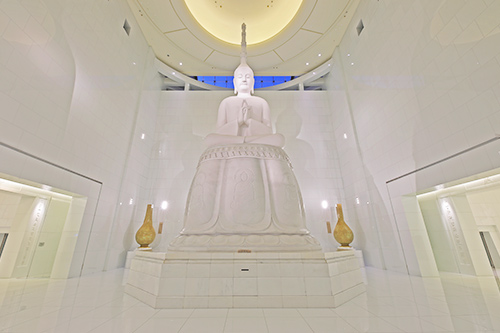
The Great Enlightenment Hall on the ninth floor was built using all white materials to represent the pure intrinsic nature of sentient beings. A statue of Vairochana Buddha, or Dharma Body, sits in the middle of the hall. It is surrounded by crystallized glass, mirror-like and reflecting all forms, which symbolizes the intrinsic purity and empty nature of the Dharma Body—the original face of all beings. The ceiling above is inlaid with fiber optic lighting to resemble stars in the night sky, reminiscent of the moment Buddha attained perfect enlightenment when gazing up at the stars.
The adjoining halls enshrine the statues of Manjushri, the Bodhisattva of Great Wisdom and Samantabhadra, the Bodhisattva of Great Action. They are two of the four bodhisattva halls in Chung Tai Chan Monastery.
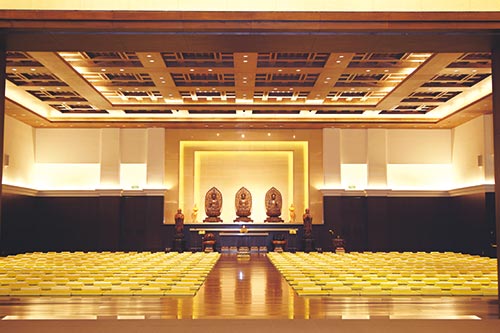
The Chan Hall is the heart of a Chan monastery, where meditation is the primary method of cultivation. A furnace that burns away impurities, the Chan Hall is where practitioners go to forge the enlightened mind. Entering the hall, they let go of all worldly concerns and focus intently on understanding their true nature.
The Great Chan Hall on the fifth floor and the Upper Chan Hall on the ninth form the center of the monastery. Directly facing the halls are buddha statues: the Bliss Body sits in front of the Great Chan Hall, and the Dharma Body faces the Upper Chan Hall. Their placement coveys the Buddhist teaching of causality. Through diligent meditation, one sees into one’s true nature and plants the seed of enlightenment. The complete realization of enlightenment is the fruit of buddhahood, aspects of which are expressed by the threefold body—infinite compassion, wisdom, and unconditioned reality.
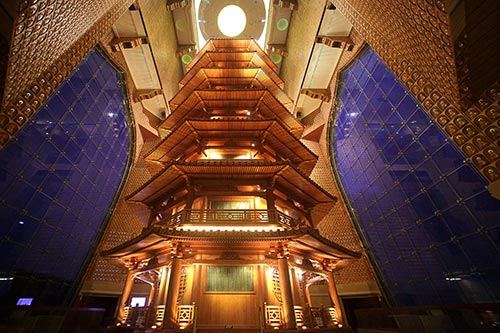
Over ten thousand hand-cast copper tiles of the Medicine Buddha cover the Hall of Ten Thousand Buddhas. In the center of the hall is a seven-story pagoda representing the Three Jewels of Buddhism—the Buddha, Dharma, and Sangha.
The pagoda was built from Myanmar teakwood using traditional joinery techniques forgoing the use of nails. Inside are seven statues of the Medicine Buddha and wooden reliefs of the 500 arhats based on ink rubbings from Tianning Temple. The exterior is engraved with The Diamond Sutra, a central text of the Mahayana tradition.
The Hall of Ten Thousand Buddhas features two 30-meter high tension supported glass facades that provide a view of the pagoda from afar. The glass panels can oscillate 43.9 cm to resist earthquakes and strong winds. Though the lotus-petal-shaped windows, light from the pagoda can be seen shining like a beacon after dark, guiding wayward beings back to their original nature.
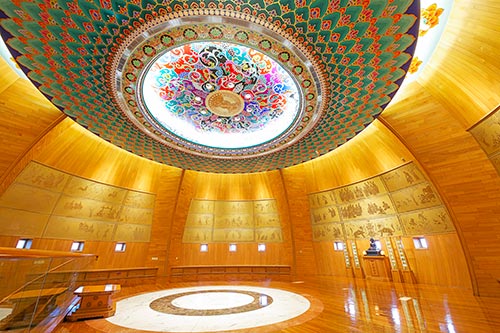
The apex of the monastery is the Golden Dome, which represents a precious mani pearl, symbol of the perfect nature in all beings. The dome’s exterior is plated with golden titanium and topped with a nine-wheeled tasha, symbolizing the turning of the Dharma wheel. The interior is floored and paneled with cypress and the walls are lined with titanium etchings depicting scenes from the Buddha’s past lives, where he practiced the six paramitas on the path to buddhahood. At the center of the ceiling is the emblem of Chung Tai holding a flower, surrounded by colorfully painted lotus petals.
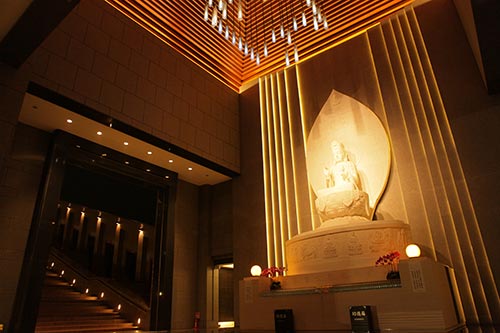
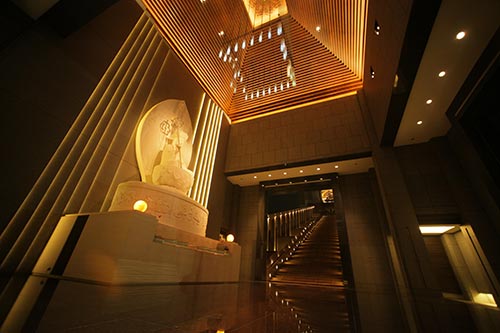
Flanking the center of the monastery are two stairways: the eastern stairway leads to Guanyin (Avalokiteshvara) Bodhisattva Hall, and the western stairway to Dizang (Ksitigarbha) Bodhisattva Hall. Together they symbolize the path of gradual cultivation, a bodhisattva’s practice of the six paramitas along the path to buddhahood. Participants in the “mountain pilgrimage” climb these stairs while chanting the Buddha’s name and prostrating every three steps. It is a practice in mindfulness, tolerance, repentance, and humility, where pilgrims ascend the stairs to enlightenment, one step at a time.
Inside Guanyin Hall sits a statue of the bodhisattva. Its outer wall is engraved with The Universal Gateway of Guanyin Bodhisattva, a chapter from The Lotus Sutra. It describes Guanyin’s immeasurable compassion and vow to answer the cries of all sentient beings. The statue of Guanyin holds a vase of pure water and sits on a lotus pedestal as symbols of her bodhisattva vows.
On the other side of the monastery is Dizang Hall. It is engraved with The Sutra of the Original Vow of Ksitigarbha Bodhisattva, which records the bodhisattva’s vow to delay his own buddhahood until all sentient beings are enlightened. The statue of Dizang sits underneath a 37-tiered ceiling and 37 hanging lights, representing the 37 factors of enlightenment. An image of a lotus flower containing 12 seeds represents the 12 links of interdependence.